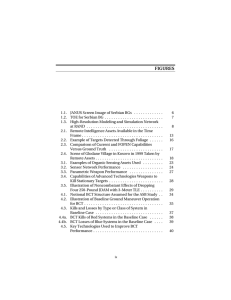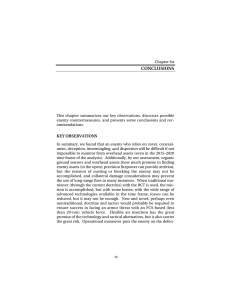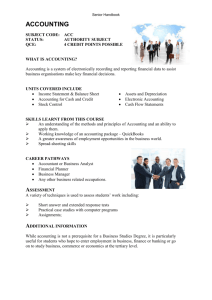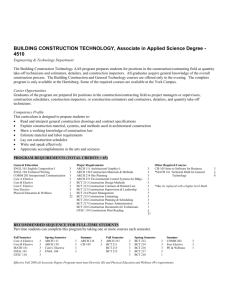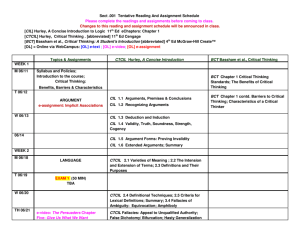SUMMARY
advertisement
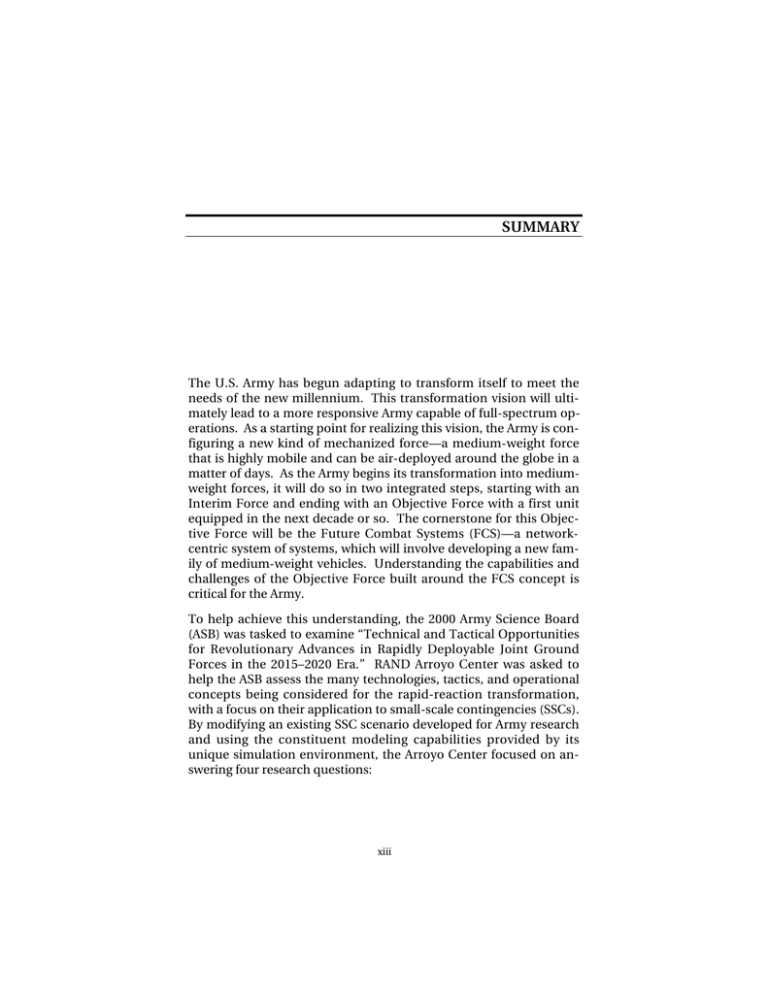
SUMMARY The U.S. Army has begun adapting to transform itself to meet the needs of the new millennium. This transformation vision will ultimately lead to a more responsive Army capable of full-spectrum operations. As a starting point for realizing this vision, the Army is configuring a new kind of mechanized force—a medium-weight force that is highly mobile and can be air-deployed around the globe in a matter of days. As the Army begins its transformation into mediumweight forces, it will do so in two integrated steps, starting with an Interim Force and ending with an Objective Force with a first unit equipped in the next decade or so. The cornerstone for this Objective Force will be the Future Combat Systems (FCS)—a networkcentric system of systems, which will involve developing a new family of medium-weight vehicles. Understanding the capabilities and challenges of the Objective Force built around the FCS concept is critical for the Army. To help achieve this understanding, the 2000 Army Science Board (ASB) was tasked to examine “Technical and Tactical Opportunities for Revolutionary Advances in Rapidly Deployable Joint Ground Forces in the 2015–2020 Era.” RAND Arroyo Center was asked to help the ASB assess the many technologies, tactics, and operational concepts being considered for the rapid-reaction transformation, with a focus on their application to small-scale contingencies (SSCs). By modifying an existing SSC scenario developed for Army research and using the constituent modeling capabilities provided by its unique simulation environment, the Arroyo Center focused on answering four research questions: xiii xiv Exploring Technologies for the Future Combat Systems Program • How much remote “situational understanding” is achievable in the 2015–2020 time frame? • What can be accomplished using a full range of joint assets without close combat (manned)? • Does adding ground maneuver, possibly close combat, with the brigade combat team (BCT) offer advantages? • What are the implications of enhanced air insertion of the BCT, such as vertical envelopment? RESEARCH FINDINGS Our research findings fundamentally consist of answers to the above questions. Given the relatively short time frame allowed for this study, and in particular for those questions requiring simulationbased modeling, very little sensitivity analysis was achievable. As a result, the answers provided below are conditional on key assumptions, which show up as caveats to the analysis throughout this document. Answer 1: Remote Assets Will Not Ensure “Understanding” on the Future Battlefield Although significant strides are clearly being made in remote reconnaissance, intelligence, surveillance, and target acquisition capability out to year 2020 and beyond, our initial assessment suggests that such capabilities, even if pursued aggressively, cannot alone ensure adequate situational understanding.1 The physical environment (e.g., weather, foliage), the presence of noncombatants, and the countermeasure options available to an adversary (especially within the representative SSC used in this research) all provide challenges and complications that limit what can be accomplished from afar. Even rapidly improving foliage-penetrating (FOPEN) radar and ______________ 1 Remote assets as defined here include medium- and high-altitude and space-based assets. Excluded are ground-based sensors such as robotic sensors and distributed sensor networks. Although we examined a large suite of remote assets, this was not a comprehensive set. It is possible that other technologies can improve the picture, but there will likely be a range of countermeasures. Summary xv hyperspectral sensing cannot guarantee detection. In many ways, the SSC’s fundamental nature exacerbates these factors as compared to a major theater war (MTW) (e.g., the need to distinguish between noncombatants and adversaries may be typical for the SSC-level operation). Answer 2: Advanced Remote Application of Firepower Can Produce Attrition, but Considerable Collateral Damage Is Likely The second research question asks to what extent the mission can be accomplished without resorting to ground forces. Because the remote sensors provide only a partial understanding of the situation, we added (with ASB input) a sophisticated tactical sensor network deemed achievable in the 2015–2020 time frame that included advanced distributed sensors, tactical unmanned aerial vehicles (UAVs), and special hovering UAVs. All systems incorporate advanced sensor technologies that would be cued by the full range of remote assets, including FOPEN radar, available in the 2015–2020 time frame. With this sensor network capability, along with major advances in precision-guided weaponry, as many as one-third of all enemy forces can be engaged and, with highly aggressive application of precisionguided standoff weapons, ultimately attrited. However, such an aggressive use of even the most advanced precision-guided weaponry is likely to come at the cost of significant noncombatant losses and collateral damage. Our estimates, based on population densities of the region during the early days of the SSC scenario we studied, conservatively suggest at least a few thousand casualties, either injured or killed.2 Furthermore, despite the high levels of attrition suffered by enemy forces, our analysis suggests that such standoff capability will not ensure accomplishment of the military mission in the SSC, as defined by the scenario. The fundamental reason is the inability to decisively ______________ 2 The Appendix contains the details of a methodology used to estimate casualties; data for the methodology were based on civilian behavior and flow rates during the early phases of Operation Allied Force. xvi Exploring Technologies for the Future Combat Systems Program stop the ingress of enemy units; thus, enemy presence can be reinforced over time. Finally, based on historical evidence seen in the event that is the basis of the scenario we studied, countermeasures would most likely be implemented to reduce the effectiveness of both sensors and weapons associated with standoff attacks. Answer 3: Using Ground Forces Allows the Mission to Be Accomplished but with Some Losses To answer the third question about the contribution of a ground force attack, we used a notional brigade combat team (BCT) and applied the force to the scenario using current doctrine, tactics, techniques, and procedures.3 In this context, the BCT must enter through mountain passes, with the objective of evicting the in-place forces and blocking follow-on reinforcements. Generally, we found that the mission can be accomplished, but with some cost. Since the enemy has the terrain, preparation, and cover, the notional BCT is at a great disadvantage from the onset. Since an Active Protection System (APS) was identified as one of the BCT’s key enabling technologies, we evaluated the BCT performance both with and without this capability. In both cases, we then added different versions of robotic vehicles to be used in the high-risk, reconnaissance mission: the first was an unarmed robotic vehicle, equipped with a second-generation mast-mounted forward-looking infrared, that was linked to an FCS direct-fire vehicle; the second was an armed robotic vehicle that would engage with its own notional direct-fire weapon; and the third was an armed robotic vehicle equipped with muzzle-flash detection, which would permit engagement without the need to recognize the target. Finally, we included a case that included long-range fires. The simulation shows that the most dramatic effect is adding the long-range fires capability to all the other added capabilities, which raised the loss-exchange ratio from the baseline 1.25 in the no-APS case (1.59 in the APS case) to 4.04 and 4.87, respectively; however, the addition of long-range fires did result in over a thousand noncombatant casualties. ______________ 3 Because there was not an approved operational and organizational construct for the BCT, we used best-estimate inputs for our research. Summary xvii Answer 4: Successful Vertical Envelopment Transforms the Mission from Offense to Defense The last research question involved assessing the utility of the Future Transport Rotorcraft (FTR) to operationally insert the notional BCT. Here, the ASB selected landing zones well into hostile territory. This aggressive action changes the fight from a more traditional ground maneuver into a nonlinear engagement, with the BCT threatening from different positions. Not only did the use of the FTR provide flexibility to leverage intelligence, terrain, and positioning, the insertion also transformed the Blue force mission from an offensive action to a defensive one. If successful insertion is assumed (which is not resolved at this time), this capability results in a much more favorable outcome. Despite the protection systems that are becoming available for aircraft, the asymmetric nature of the air defense threat to aircraft suggests that significantly more improvements will be needed to enable this kind of mission. As an alternative, the FTR or C-130Js (with modification) could be used to deploy forces forward, and these ground forces could then maneuver under the enemy air defense umbrella to their objective. This could result in an outcome as favorable as the one achieved with vertical envelopment. CONCLUSIONS Given the strong influence that SSC-related factors impose on combat and its conduct in the future, it follows that as the Army redesigns itself to respond out 15 to 20 years, these factors should be integrated into the design process. This study represents only a beginning part of this challenging process. Key Observations In summary, we found that an enemy who relies on cover, concealment, deception, intermingling, and dispersion will be very difficult to monitor from overhead assets (even in the 2015–2020 time frame of the analysis). While combined uses of organic, tactical sensors and remote assets show much promise in finding enemy assets, these systems tend to become much more constrained in areas with xviii Exploring Technologies for the Future Combat Systems Program dense foliage. While advances in remote precision firepower will probably be able to provide some level of attrition (e.g., small smart bombs), attrition by itself will not necessarily accomplish the mission. The enemy can still reinforce, possibly at a faster rate than the attrition. Further, risk to noncombatants and collateral damage considerations may limit the use of such fires in many instances. These factors combined highlight the need for some level of presence on the ground. When traditional maneuver (through the current doctrine) with the notional BCT is used, the mission is accomplished, but with some losses; with the wide range of advanced technologies available in the time frame, losses can be reduced, but perhaps not by enough. New and novel, perhaps even nontraditional, doctrine and tactics will most likely be required to ensure success in putting a force based on 20-ton vehicles against a traditional heavy armor threat. Flexible air insertion shows much promise, but this also can carry great risk. Such expedient operational maneuver capability offered by a FTR can change the dynamics of battle by allowing a force to get into key positions before they are contested. As a result, less predictable offensive tactics can be used, and forward-based defensive strong points can be established. However, survivability of such aircraft is not yet resolved, which places a high priority on the development of multispectral protection systems should this capability be implemented. Potential Enemy Countermeasures The obvious question facing any long-term technology improvement program is what the enemy can do to counter it. The responses range from deception to direct attack on vulnerable systems and range across those directed at long-range fires (remote attack), those directed against a BCT ground attack, and those directed at a vertical envelopment attack. In terms of the first use, countermeasures— such as hiding well within tree lines or covered urban areas but with good line of sight (LOS) and field of fire—can be especially effective when the Blue forces are relying on standoff sensors and long-range fires. In addition, the deceptions do not have to be perfect; techniques that save a few more units, personnel, and equipment can lead to more Blue losses later during ground attack options. More- Summary xix over, the techniques are relatively inexpensive and readily available or producible. Countermeasures against the notional BCT ground attack include using extensive combined arms “strong point” (especially in urban areas with noncombatants) and “hardening” targets, preparing infantry and armor “dug-in” ambush positions, using cover and concealment during the resupply movement, and calling on cannons, mortars, and multiple rocket launchers for fire support. Although these techniques are labor-intensive and require time and resources to implement, they can readily be accomplished by even poor armies. Finally, the enemy’s attack of FTR lift assets is particularly dangerous for the Blue force. Simulation runs showed the Blue force losing most of the FTR fleet to the enemy’s robust air defense. Particular countermeasures include locating air defense artillery assets to destroy the FTR during both ingress and egress, attacking landing zones with long-range artillery, and attacking Blue forces from multiple directions to cut forces off. RECOMMENDATIONS Although it is not necessarily obvious, an SSC can in some ways be more complex to conduct than an MTW. As we observed in the context of this research, the capability to accomplish military objectives may come second to the conditions and constraints imposed by the SSC itself. As a result, even 15 to 20 years out, the available suite of remote sensors and precision-guided weapons is not a panacea; indeed, even if such forecasted remote capabilities had been available in 1999, many of the challenges seen in the event that defined our scenario would have been the same. A new medium-weight force, such as the notional BCT considered here, represents a more direct method for responding to such challenges, providing a means for direct tactical target engagement with the ability to discriminate noncombatants. However, we note that having the ability to deploy rapidly, in and of itself, may not be enough. Other measures may be needed. xx Exploring Technologies for the Future Combat Systems Program For one, policy may need to be adjusted to reflect the capability of the unit itself. That is, having the capability to deploy quickly may ultimately mean very little if the decision to use the force covers a lengthy period. Thus, if policy and guidelines are not integrated with the new capability, they may become the constraining factor. Such policy issues should be researched further. For another, to be successful the BCT may have to have contain various technology enhancements. The key technologies identified for the notional BCT in this research were intelligence systems and tactical sensor networks; robotics-related technologies, such as advanced UAVs and unmanned ground vehicles; weapons (both direct and indirect) that can engage through foliage; and protection systems for ground and air vehicles. These can provide considerable and needed improvement toward BCT mission effectiveness. The most favorable outcomes, however, occurred when a joint force was used—specifically, when ground forces such as the BCT were complemented with a range of appropriate remote sensors and weapons. Although casualties are likely with the aggressive use of remote weapons, the presence of a ground force can help to mitigate this. Similarly, ground forces, without the “softening” effect of standoff engagement, were more susceptible to being ambushed and engaged by heavy armor. We emphasize that the SSC examined here is only one of many situations that should be considered when evaluating major acquisition decisions. Other scenarios and missions should be explored in a wide range of locations. In addition, we note that in this quickresponse study, only a handful of key technology areas were ultimately examined and assessed. This set should certainly be expanded to include the many other ideas being generated. Although there will most likely be a continuing desire to resolve the SSC class of crises through remote application of force, many of the tactics and technologies associated with these kinds of engagements come with major limitations, and those limitations should be evaluated and understood more fully (and assessed with risk mitigation) as the Army and DARPA explore various joint concepts and designs for the Objective Force.
